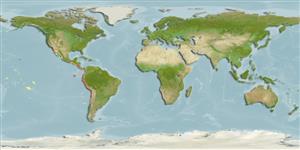Teleostei (teleosts) >
Perciformes/Serranoidei (Groupers) >
Serranidae (Sea basses: groupers and fairy basslets)
Etymology: Paralabrax: Greek, para = the side of + Greek, labrax, -akos = a fish, Dicentrarchus labrax (Ref. 45335).
More on author: Valenciennes.
Environment: milieu / climate zone / depth range / distribution range
Ecology
Marine; benthopelagic; depth range 60 - 180 m (Ref. 5530). Tropical; 31°N - 34°S
East Pacific: Costa Rica, Colombia to extreme south of Chile. Records from Juan Fernández Is. are incidental (Ref. 89357). Records from Baja California, Mexico, Nicaragua and the Galapagos Islands are doubtful.
Length at first maturity / Size / Weight / Age
Maturity: Lm 26.9 range ? - ? cm
Max length : 54.5 cm TL male/unsexed; (Ref. 53696); max. published weight: 2.5 kg (Ref. 53696)
Occurs in schools (Ref. 5530). Known from a temperature range of 14-16 °C (Ref. 9098). Also caught with trammel nets (Ref. 9342). An appreciated food fish in Peru (Ref. 9342).
Life cycle and mating behavior
Maturity | Reproduction | Spawning | Eggs | Fecundity | Larvae
Also Ref. 103751.
Heemstra, P.C., 1995. Serranidae. Meros, serranos, guasetas, enjambres, baquetas, indios, loros, gallinas, cabrillas, garropas. p. 1565-1613. In W. Fischer, F. Krupp, W. Schneider, C. Sommer, K.E. Carpenter and V. Niem (eds.) Guia FAO para Identification de Especies para lo Fines de la Pesca. Pacifico Centro-Oriental. 3 Vols. FAO, Rome. (Ref. 9342)
IUCN Red List Status (Ref. 130435: Version 2024-1)
Threat to humans
Harmless
Human uses
Fisheries: commercial
Tools
Special reports
Download XML
Internet sources
Estimates based on models
Preferred temperature (Ref.
123201): 11.5 - 17.1, mean 15 °C (based on 41 cells).
Phylogenetic diversity index (Ref.
82804): PD
50 = 0.5020 [Uniqueness, from 0.5 = low to 2.0 = high].
Bayesian length-weight: a=0.01047 (0.00557 - 0.01970), b=3.05 (2.89 - 3.21), in cm total length, based on LWR estimates for this species & Genus-body shape (Ref.
93245).
Trophic level (Ref.
69278): 4.1 ±0.5 se; based on diet studies.
Resilience (Ref.
120179): Medium, minimum population doubling time 1.4 - 4.4 years (tm=2).
Fishing Vulnerability (Ref.
59153): Moderate vulnerability (42 of 100).
Climate Vulnerability (Ref.
125649): Moderate vulnerability (40 of 100).
Nutrients (Ref.
124155): Calcium = 73.7 [31.6, 146.4] mg/100g; Iron = 0.827 [0.437, 1.547] mg/100g; Protein = 17.2 [15.4, 18.9] %; Omega3 = 0.259 [0.147, 0.451] g/100g; Selenium = 71.9 [38.6, 155.3] μg/100g; VitaminA = 46.2 [16.4, 151.5] μg/100g; Zinc = 0.915 [0.631, 1.330] mg/100g (wet weight);
